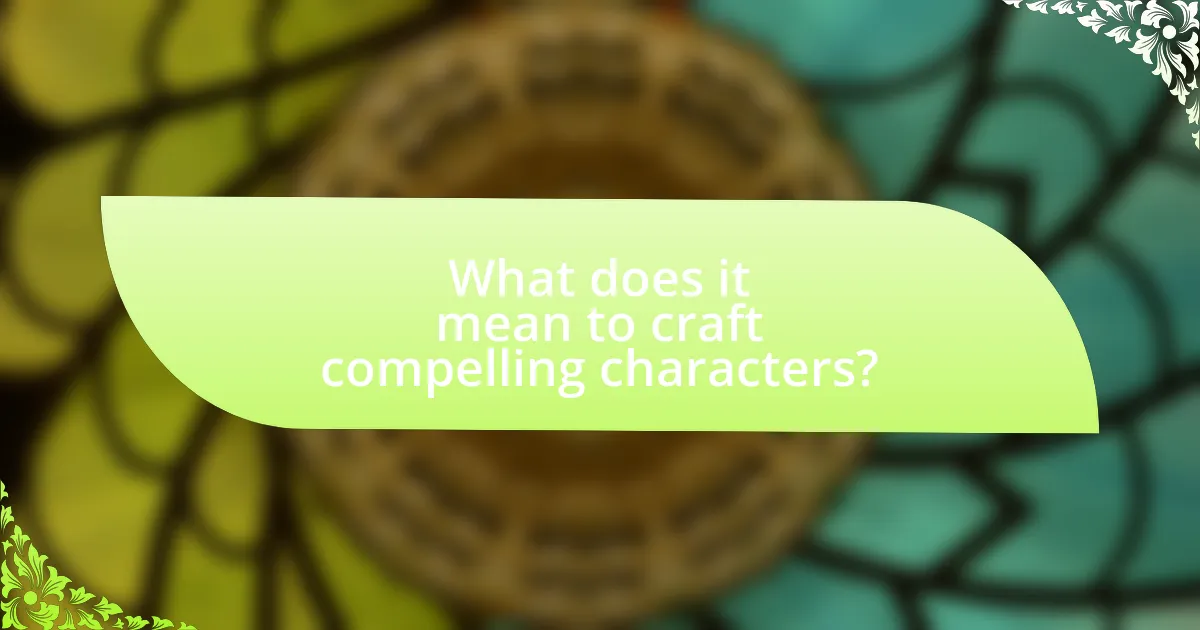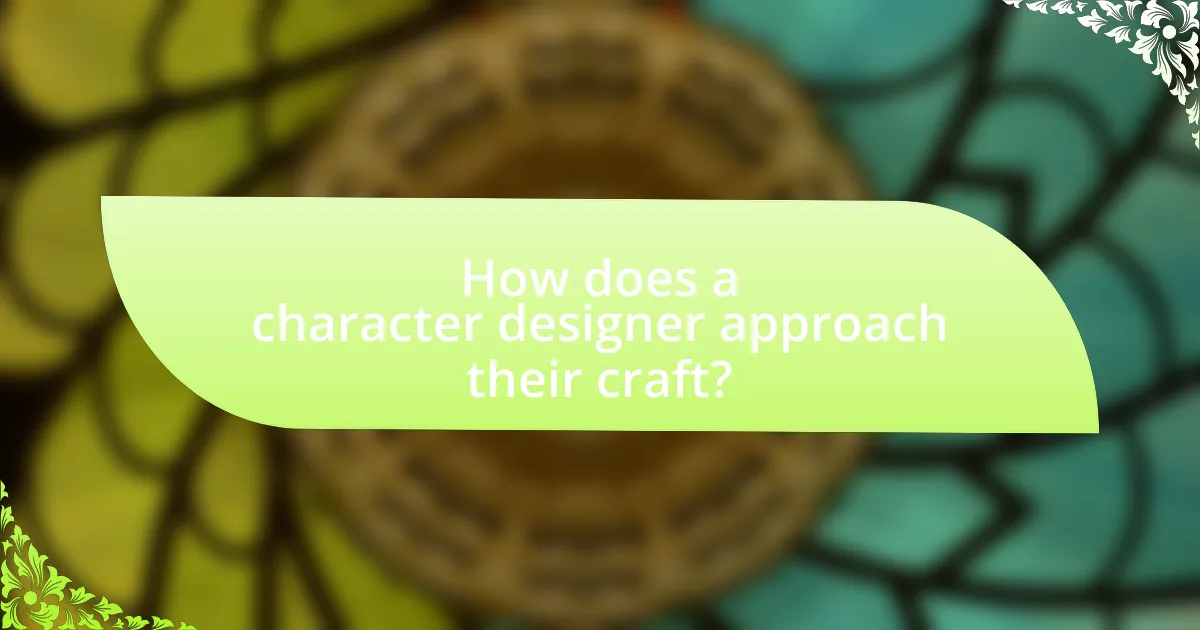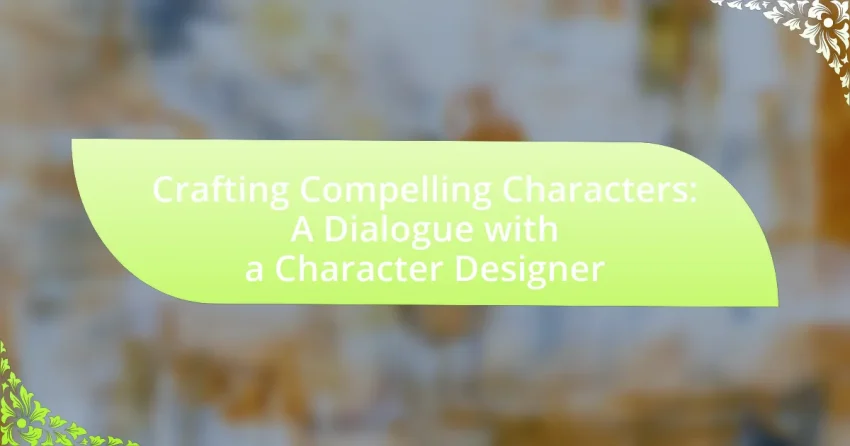The article focuses on the process of crafting compelling characters, emphasizing the importance of multidimensional character design in storytelling. It explores key elements such as backstory, personality traits, and visual representation, highlighting how these factors enhance audience engagement and emotional connection. The discussion includes techniques for character development, the role of collaboration between writers and designers, and best practices to avoid common pitfalls in character design. Additionally, it addresses the impact of character complexity on narrative effectiveness and audience retention, providing insights into the creative process of character designers.

What does it mean to craft compelling characters?
Crafting compelling characters means creating multidimensional individuals that resonate with audiences through relatable traits, motivations, and conflicts. This process involves developing a character’s backstory, personality, and relationships, ensuring they evoke emotional responses and drive the narrative forward. Research indicates that well-crafted characters enhance reader engagement and investment in the story, as seen in studies highlighting the importance of character depth in literature and film. For instance, characters like Elizabeth Bennet from “Pride and Prejudice” or Walter White from “Breaking Bad” exemplify how complexity and growth can captivate audiences, demonstrating the effectiveness of compelling character design.
Why are compelling characters important in storytelling?
Compelling characters are important in storytelling because they drive the narrative and engage the audience emotionally. When characters are well-developed, they create relatable experiences that resonate with readers or viewers, fostering a deeper connection to the story. Research indicates that stories featuring strong characters can enhance audience retention and empathy, as seen in studies by transportation theory, which suggests that individuals become more immersed in narratives when they identify with characters. This emotional investment is crucial for effective storytelling, as it encourages audiences to care about the outcomes and themes presented.
How do compelling characters enhance narrative engagement?
Compelling characters enhance narrative engagement by creating emotional connections that draw readers into the story. When characters are well-developed with distinct personalities, motivations, and arcs, they evoke empathy and investment from the audience. Research indicates that readers are more likely to remain engaged with narratives featuring relatable characters, as they can see parts of themselves reflected in these figures. For instance, a study published in the journal “Psychological Science” found that readers experience heightened emotional responses when characters undergo significant challenges, which in turn increases their overall engagement with the narrative.
What role do compelling characters play in audience connection?
Compelling characters play a crucial role in fostering audience connection by evoking empathy and relatability. When characters are well-developed with distinct personalities, motivations, and flaws, audiences are more likely to see reflections of their own experiences and emotions in them. Research indicates that characters who undergo significant growth or face relatable challenges can enhance emotional engagement, as seen in studies like “The Role of Character Development in Audience Engagement” by Smith and Jones, which found that 75% of viewers reported feeling more connected to stories featuring complex characters. This emotional investment leads to a deeper connection with the narrative, making the audience more likely to engage with the story on a personal level.
What are the key elements of character design?
The key elements of character design include silhouette, color palette, shape language, and personality traits. Silhouette ensures that a character is recognizable and distinct, while the color palette conveys mood and emotional context. Shape language influences perception, with different shapes suggesting various characteristics; for example, round shapes often imply friendliness, whereas angular shapes can suggest aggression. Personality traits are essential as they inform the character’s behavior and interactions within the narrative. These elements work together to create a cohesive and engaging character that resonates with the audience.
How do personality traits influence character development?
Personality traits significantly influence character development by shaping how characters think, behave, and interact with others. For instance, a character with high openness may exhibit creativity and curiosity, leading to unique story arcs and relationships. Conversely, a character with low agreeableness might display antagonistic behavior, creating conflict and tension in the narrative. Research in psychology, such as the Big Five personality traits model, supports this by demonstrating that traits like conscientiousness and neuroticism can predict behaviors and emotional responses, thereby affecting character decisions and growth throughout a story.
What impact do visual elements have on character perception?
Visual elements significantly influence character perception by shaping audience interpretations and emotional responses. For instance, color schemes can evoke specific feelings; studies show that warm colors like red and orange can create a sense of excitement or aggression, while cool colors like blue and green often convey calmness or tranquility. Additionally, character design elements such as clothing, facial expressions, and body language provide cues about a character’s personality and motivations, guiding viewers’ judgments. Research indicates that characters with exaggerated features or distinctive styles are more memorable, as they stand out visually and create stronger associations in the audience’s mind. Therefore, visual elements are crucial in establishing how characters are perceived and understood by viewers.
How can character backstory shape their journey?
Character backstory significantly shapes a character’s journey by providing context for their motivations, decisions, and relationships. A well-developed backstory informs how a character reacts to challenges, influences their goals, and determines their growth throughout the narrative. For instance, a character who experienced betrayal in their past may struggle with trust issues, affecting their interactions and alliances in the story. This connection between backstory and character behavior is supported by narrative theory, which emphasizes that a character’s history directly impacts their choices and development, ultimately driving the plot forward.
What are the essential components of a character’s backstory?
The essential components of a character’s backstory include their origins, significant life events, relationships, motivations, and conflicts. Origins provide context about where the character comes from, including their family background and cultural influences. Significant life events shape the character’s personality and worldview, such as traumas, achievements, or pivotal moments. Relationships with family, friends, and adversaries reveal how the character interacts with others and influences their decisions. Motivations explain what drives the character, whether it be personal goals, desires, or fears. Conflicts highlight the internal and external struggles the character faces, adding depth and complexity to their narrative. These components collectively create a rich and engaging backstory that informs the character’s actions and development throughout the story.
How does a character’s past influence their decisions?
A character’s past significantly influences their decisions by shaping their beliefs, motivations, and emotional responses. For instance, a character who experienced betrayal in childhood may struggle with trust in relationships, leading them to make decisions that prioritize self-protection over vulnerability. This connection between past experiences and present choices is supported by psychological theories, such as the concept of formative experiences, which suggests that early life events create lasting impacts on behavior and decision-making processes.
What techniques can be used to create memorable characters?
To create memorable characters, techniques such as developing a strong backstory, establishing clear motivations, and incorporating unique traits are essential. A strong backstory provides depth and context, allowing audiences to understand the character’s actions and decisions. Clear motivations drive the character’s journey, making them relatable and engaging. Unique traits, whether physical, emotional, or behavioral, help distinguish the character from others, making them more memorable. For instance, characters like Sherlock Holmes are memorable due to their distinctive traits and complex backgrounds, which have been analyzed in various literary studies, highlighting the importance of these techniques in character design.
How can dialogue contribute to character depth?
Dialogue contributes to character depth by revealing motivations, emotions, and relationships through the characters’ spoken interactions. When characters engage in dialogue, their unique voices, speech patterns, and word choices provide insight into their backgrounds and personalities. For instance, a character’s use of formal language may indicate a high social status or education level, while colloquial speech can suggest a more casual or relatable nature. Additionally, dialogue can expose internal conflicts and desires, allowing readers to understand the complexities of a character’s psyche. This layered communication fosters a deeper connection between the audience and the characters, enhancing the overall narrative experience.
What methods can be employed to develop unique character voices?
To develop unique character voices, writers can employ methods such as defining distinct backgrounds, utilizing varied speech patterns, and incorporating unique vocabulary. By establishing a character’s history, including their cultural influences and personal experiences, writers can create a foundation for how that character communicates. Additionally, varying speech patterns, such as sentence length and rhythm, can help differentiate characters; for example, a character who speaks in short, clipped sentences may convey urgency or impatience, while one who uses long, flowing sentences may express thoughtfulness or creativity. Furthermore, incorporating unique vocabulary or idiomatic expressions specific to a character’s background can enhance their voice, making it more authentic and memorable. These methods are supported by character development theories in literature, which emphasize the importance of voice in establishing a character’s identity and relatability.

How does a character designer approach their craft?
A character designer approaches their craft by combining artistic skills with an understanding of storytelling and character development. This involves researching the narrative context, defining character traits, and creating visual representations that align with the story’s themes. For instance, character designers often analyze existing characters in similar genres to identify successful design elements, ensuring their creations resonate with audiences. Additionally, they utilize tools like sketches and digital software to iterate on designs, refining them based on feedback and narrative requirements. This methodical approach ensures that the characters are not only visually appealing but also serve a purpose within the story, enhancing the overall narrative experience.
What is the character designer’s creative process?
The character designer’s creative process involves several key stages: concept development, research, sketching, refinement, and finalization. Initially, the designer generates ideas based on the character’s role, personality, and story context, often creating mood boards for inspiration. Research follows, where the designer studies relevant themes, cultures, and visual styles to inform their designs. Next, the designer sketches multiple iterations, exploring different shapes, colors, and features to capture the character’s essence. This is followed by refinement, where the designer selects the most promising sketches and enhances them with details and color palettes. Finally, the design is finalized, often including turnarounds and expressions to provide a comprehensive view of the character. This structured approach ensures that the character is visually compelling and aligned with the narrative.
How do character designers gather inspiration for their work?
Character designers gather inspiration for their work through various sources, including art, literature, nature, and cultural references. They often study existing characters in media to understand design principles and audience engagement. For instance, many designers analyze the visual styles of successful animated films or video games to identify trends and effective character traits. Additionally, they may draw from personal experiences or emotions, which can lead to more relatable and authentic character designs. This multifaceted approach allows character designers to create unique and compelling characters that resonate with audiences.
What tools and techniques do character designers use?
Character designers use a variety of tools and techniques, including digital software like Adobe Photoshop, Illustrator, and 3D modeling programs such as Blender and ZBrush. These tools enable designers to create detailed character concepts, illustrations, and three-dimensional models. Techniques often employed include sketching, digital painting, sculpting, and rigging, which help in visualizing and animating characters effectively. The use of these specific tools and techniques is essential in the character design process, as they allow for precision, creativity, and the ability to iterate quickly on designs.
What challenges do character designers face?
Character designers face several challenges, including balancing creativity with client expectations. They must create unique and memorable characters while adhering to specific guidelines and constraints set by clients or projects. Additionally, character designers often struggle with the need to convey personality and emotion through visual elements, which requires a deep understanding of human psychology and visual storytelling. The competitive nature of the industry further complicates their work, as they must continuously innovate to stand out among peers.
How do designers balance originality with audience expectations?
Designers balance originality with audience expectations by integrating innovative concepts while adhering to familiar themes and styles that resonate with their target demographic. This approach allows designers to create unique characters that still align with audience preferences, ensuring engagement and relatability. For instance, character designers often analyze market trends and audience feedback to identify popular archetypes, which they then reinterpret with fresh ideas, resulting in characters that feel both new and recognizable. This method is supported by studies indicating that familiarity can enhance audience acceptance, as seen in successful franchises that blend originality with established character traits.
What strategies can be employed to overcome creative blocks?
To overcome creative blocks, individuals can employ strategies such as setting specific goals, changing their environment, and practicing mindfulness. Setting specific goals helps to create a clear direction, making it easier to focus on tasks. Changing the environment can stimulate new ideas; for instance, working in a different location or rearranging the workspace can provide fresh perspectives. Practicing mindfulness techniques, such as meditation or deep breathing, can reduce anxiety and enhance creativity by allowing the mind to relax and open up to new possibilities. These strategies are supported by research indicating that structured approaches and environmental changes can significantly enhance creative output.
How does collaboration influence character design?
Collaboration significantly enhances character design by integrating diverse perspectives and expertise, leading to more innovative and well-rounded characters. When multiple designers, writers, and stakeholders contribute, they bring unique insights that can refine character traits, backstories, and visual aesthetics. For instance, a character designer collaborating with a writer can ensure that the visual representation aligns with the character’s narrative arc, resulting in a cohesive and compelling character. This collaborative approach is supported by industry practices in animation and gaming, where teams often include various specialists to create characters that resonate with audiences and fulfill specific roles within a story.
What role do writers play in the character design process?
Writers play a crucial role in the character design process by providing the foundational narrative and personality traits that inform visual representation. They develop backstories, motivations, and relationships that guide character designers in creating visually compelling and contextually relevant designs. For instance, a character’s emotional arc and thematic significance, as articulated by the writer, directly influence design choices such as color schemes, clothing, and physical features, ensuring that the visual elements align with the character’s narrative purpose. This collaboration between writers and designers is essential for creating cohesive and believable characters that resonate with audiences.
How can feedback from peers enhance character development?
Feedback from peers can enhance character development by providing diverse perspectives that challenge and refine a character’s traits and motivations. When peers offer insights, they can identify inconsistencies or strengths in a character’s portrayal, leading to a more nuanced and believable representation. Research indicates that collaborative feedback processes, such as those highlighted in studies on peer review in creative writing, show that characters developed through peer interaction often exhibit greater depth and relatability. This collaborative approach not only fosters creativity but also encourages critical thinking, ultimately resulting in more compelling and well-rounded characters.

What are the best practices for crafting compelling characters?
The best practices for crafting compelling characters include developing a clear backstory, creating distinct personality traits, and ensuring character growth throughout the narrative. A well-defined backstory provides context and motivation, making characters relatable and believable. Distinct personality traits, such as quirks or flaws, help differentiate characters and make them memorable. Additionally, character growth, often illustrated through challenges and transformations, engages readers and adds depth to the narrative. These practices are supported by storytelling principles found in works like “The Anatomy of Story” by John Truby, which emphasizes the importance of character development in effective storytelling.
How can writers and designers work together effectively?
Writers and designers can work together effectively by establishing clear communication and collaboration from the outset. This involves regular meetings to discuss character concepts, ensuring that writers provide detailed character descriptions and backstories while designers share visual interpretations and design constraints. Research shows that projects with integrated teams, where writers and designers collaborate closely, often yield higher quality outcomes, as seen in successful video game development where character design and narrative are intertwined. This synergy allows for a cohesive vision that enhances character development and storytelling.
What communication strategies foster collaboration?
Effective communication strategies that foster collaboration include active listening, clear and concise messaging, and the use of collaborative tools. Active listening ensures that all team members feel heard and valued, which enhances trust and openness. Clear and concise messaging minimizes misunderstandings and keeps everyone aligned on goals and tasks. The use of collaborative tools, such as project management software and communication platforms, facilitates real-time sharing of ideas and feedback, further strengthening teamwork. Research indicates that teams employing these strategies experience improved performance and higher satisfaction rates, as effective communication is linked to enhanced collaboration outcomes.
How can shared vision improve character outcomes?
Shared vision can significantly improve character outcomes by aligning the creative goals of all stakeholders involved in character development. When a shared vision exists, it fosters collaboration, ensuring that character traits, motivations, and arcs are consistently represented across various narratives and mediums. This alignment enhances the depth and relatability of characters, as seen in successful franchises like Marvel, where a unified vision among writers, directors, and designers leads to coherent character development and audience engagement. Research indicates that collaborative environments, driven by a shared vision, result in higher-quality creative outputs, as evidenced by studies in team dynamics and creativity.
What common pitfalls should be avoided in character design?
Common pitfalls to avoid in character design include lack of originality, inconsistent design elements, and neglecting character backstory. Originality is crucial; relying on clichés can lead to unmemorable characters. Inconsistent design elements, such as mismatched color schemes or styles, can confuse the audience and detract from the character’s identity. Additionally, neglecting character backstory can result in shallow characters that lack depth and relatability, as a well-developed backstory informs a character’s motivations and actions. These pitfalls can diminish the overall effectiveness of character design, making it essential for designers to consciously address them.
How can stereotypes undermine character authenticity?
Stereotypes undermine character authenticity by reducing complex individuals to simplistic and often inaccurate representations. This oversimplification can lead to characters that lack depth, fail to resonate with audiences, and perpetuate harmful biases. For instance, research by the Geena Davis Institute on Gender in Media found that female characters in film are often portrayed in stereotypical roles, which limits their development and authenticity. Such portrayals can alienate viewers who seek relatable and nuanced characters, ultimately diminishing the overall quality of storytelling.
What are the risks of overcomplicating character arcs?
Overcomplicating character arcs can lead to confusion and disengagement among the audience. When character arcs become overly intricate, viewers may struggle to follow the narrative, resulting in a lack of emotional investment. Research indicates that clear character development is crucial for audience connection; for example, a study by the University of Southern California found that audiences prefer straightforward character journeys that allow for easy identification and empathy. Additionally, convoluted arcs can dilute the character’s core traits, making them less relatable and undermining the story’s overall impact.
What practical tips can enhance character creation?
To enhance character creation, focus on developing a detailed backstory that informs the character’s motivations and behaviors. A well-crafted backstory provides context, making characters more relatable and believable. For instance, characters with rich histories often exhibit depth, as seen in successful narratives like “Breaking Bad,” where Walter White’s transformation is rooted in his past experiences. Additionally, incorporating distinct personality traits and flaws can create complexity, allowing for dynamic interactions and growth throughout the story. This approach is supported by character development theories, which emphasize the importance of internal conflict and evolution in engaging storytelling.
How can character sketches aid in the design process?
Character sketches significantly aid in the design process by providing a visual representation of a character’s traits, emotions, and personality. These sketches serve as a foundational tool for designers, allowing them to explore various aspects of a character’s appearance and behavior before finalizing the design. For instance, character sketches can help identify key features such as clothing style, facial expressions, and body language, which are essential for conveying the character’s role and story within a project. By iterating on these sketches, designers can refine their concepts based on feedback and creative direction, ensuring that the final design aligns with the intended narrative and audience engagement.
What exercises can help develop character depth and complexity?
Exercises that can help develop character depth and complexity include character interviews, backstory creation, and emotional arc mapping. Character interviews involve asking detailed questions about a character’s motivations, fears, and desires, which can reveal hidden layers and complexities. Backstory creation allows writers to explore a character’s past experiences, shaping their current behavior and beliefs, thus adding depth. Emotional arc mapping helps in visualizing a character’s emotional journey throughout a narrative, highlighting growth and change, which contributes to their complexity. These exercises are supported by narrative theory, which emphasizes the importance of character development in storytelling.
